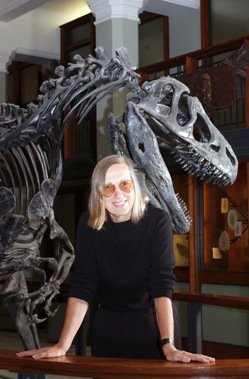 Gerta Keller, Andrew Kerr and Norman MacLeod* on a recent conference that conclusively showed how nearly all mass extinctions were principally the result of LIP eruptions.
Gerta Keller, Andrew Kerr and Norman MacLeod* on a recent conference that conclusively showed how nearly all mass extinctions were principally the result of LIP eruptions.
The Natural History Museum in London recently hosted an international multi-disciplinary conference that brought together 150 researchers in geology, geophysics, geochemistry, volcanology, sedimentology, paleontology and astronomy to review and assess recent research into the causes of mass extinction events.
Volcanism, Impacts and Mass Extinctions: Causes and Effects (March 27-29) attracted seasoned experts as well as younger researchers and students who, listening and learning from each other in spirited, constructive discussions, developed a new, collaborative, multi-disciplinary approach to resolving outstanding problems. The data and concepts presented will have value well beyond geoscience, particularly in facing modern environmental crises. Our main conclusions were as follows.
Large igneous province (LIP) volcanism, and the environmental change it wrought, probably played a significant role in at least four of the five major mass extinctions in Earth history: end-Cretaceous, end-Triassic, end-Permian (two distinct events) and end-Devonian. However, the exact causal mechanisms by which 50-90% of the species preserved in the fossil record became extinct at each event remains to be worked out. Better age-control for individual lava units and extinction events is critical to establish the relationship between causes and effects.
OVERWHELMING
There was overwhelming agreement that a single large asteroid or comet impact (Chicxulub) could not have been the sole cause of the end-Cretaceous mass extinction, but rather was a contributing factor. Long-term biological, environmental and climatic changes before, at and after the bolide impact horizon call for a multi-cause scenario, certainly involving volcanism and possibly multiple impacts or comet showers.
Participants gained an improved understanding of how LIP eruptions affect the biosphere. This included data and conclusions derived from atmospheric chemistry, geochronology of eruptions, associated mechanisms of climatic changes and the direct effects on species-level extinctions.
Mass extinction patterns can tell us much about the age, tempo and nature of the catastrophe and the type of environments most affected. We know most about the end-Cretaceous event. However, similarly detailed records are still needed for the others. If common patterns, or critical differences, between mass extinctions are found, these can yield critical evidence for or against specific extinction mechanisms.
Ultimately, the effects of volcanism, impacts, sea-level and climate change (warming and cooling), ocean acidification and anoxia, and atmospheric changes have to be considered in any extinction scenario if we are to understand the causes and consequences of mass extinctions. Moreover, these data hold keys to helping us understand and cope with the looming environmental and extinction crises in our own time.
A GSA Special Paper will be a lasting record of the meeting and act as a guide to the multi-disciplinary studies yet required to resolve outstanding problems in understanding the causes and effects of mass extinctions.
* Department of Geosciences, Princeton University, Princeton NJ, USA; Andrew C Kerr, School of Earth & Ocean Sciences, Cardiff University, UK; Norman MacLeod, The Natural History Museum, London UK